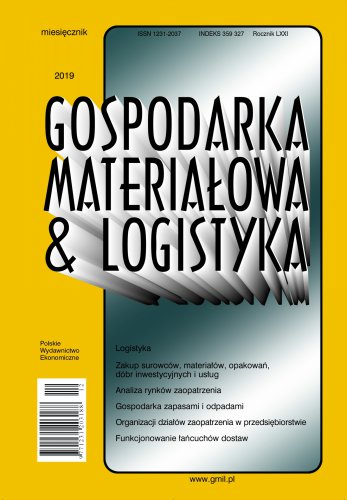Wybrane aspekty zagospodarowania gazów procesowych
Obecnie przemysł hutniczy zmaga się z problemem energetycznego wykorzystania procesowych produktów ubocznych. Zgodnie z najnowszymi dyrektywami gazy hutnicze (gaz koksowniczy COG, gaz wielkopiecowy BFG oraz gaz konwertorowy BOFG) nie powinny być produktem ubocznym, kłopotliwym do zagospodarowania. Powinny stać się nośnikiem energetycznym poprawiającym efektywność ekonomiczną oraz ekologiczną huty. Najprostszym sposobem ich zagospodarowania jest spalanie bądź współspalanie z gazem ziemnym bezpośrednio w miejscu powstawania w znajdujących się na terenie huty piecach grzewczych. Technologia ta napotyka jednak wiele trudności. Największe problemy techniczne związane są z zapewnieniem wymaganej czystości gazów oraz ciągłości dostaw gazów o odpowiednich parametrach energetycznych. Dodatkowe trudności, wynikające ze specyfiki spalanych gazów, mogą docelowo zmuszać do wprowadzania niezbędnych modyfikacji w sposobie prowadzenia procesu. Konsekwencją tego jest obniżenie efektywności ekonomicznej procesu.
Bibliografia
Bibliografia
Babiński, P., Robak, Z., Łabojko, G., Figiel, Z., Kalinowski, K. (2012). Przystosowanie gazu koksowniczego do wykorzystania w energetyce i chemii. Polityka Energetyczna, 15(4), 285–297.
Bojić, M., Tomić, M. (1998). Effect of refuse-gas fuel use on energy consumption in an industrial pusher furnace. Energy, 23(9), 767–775. https://doi.org/10.1016/S0360-5442(98)00012-7. Carpenter, A. (2012). CO2 abatement in the iron and steel industry. IEA Clean Coal Centre.
Castro, J. A. (2012). Modeling sintering process of iron ore. W: D. V. Shatokha (Red), Sintering — Methods and Products (23–46). Rijeka: INTECH. https://doi.org/10.5772/52807.
Castro, J. A., Pereira, J. L., Guilherme, V. S., Rocha, E. P., França, A. B. (2013). Model predictions of PCDD and PCDF emissions on the iron ore sintering process based on alternative gaseous fuels. Journal of Materials Research and Technology, 2(4), 323–331. https://org/10.1016/j.jmrt.2013.06.002.
Chen, W. -H., Hsu, C. -L., Du, S. -W. (2015). Thermodynamic analysis of the partial oxidation of coke oven gas for indirect reduction of iron oxides in a blast furnace. Energy, 86, 758–771. https://doi. org/10.1016/j.energy.2015.04.087.
Diemer, P., Killich, H., Knop, K., Lungen, H., Reinke, M., Schmole, P. (2004). Potentials for utilization of coke oven gas in integrated iron and steel works. W: 2nd international meeting on ironmaking/1St international symposium on iron ore. September 12–15. Espirito Santo, Brazil. Gazzani, M., Romano, M. C., Manzolini, G. (2015). CO2 capture in integrated steelworks by commercial-ready technologies and SEWGS process. International Journal of Greenhouse Gas Control, (41), 249–267. https://doi.org/10.1016/j.ijggc. 2015.07.012.
Han, S. H., Chang, D. (2012). Radiative slab heating analysis for various fuel gas compositions in an axial-fired reheating furnace. International Journal of Heat and Mass Transfer, 55(15–16), 4029–4036. https://doi.org/10.1016/j.ijheatmasstransfer.2012.03.041.
Ho, M. T., Bustamante, A., Wiley, D. E. (2013). Comparison of CO2 capture economics for iron and steel mills. International Journal Greenhouse Gas Control, (19), 145–159. https://doi.org/10.1016/j.ijggc.2013.08.003.
Hou, S. S., Chen, C. H., Chang, C. Y., Wu, C. W., Ou, J. J., Lin, T. H. (2011). Firing blast furnace gas without support fuel in steel mill boilers. Energy Conversion and Management, 52(7), 2758–2767. https://doi.org/10.1016/j.enconman.2011.02.009.
Hutnicza Izba Przemysłowo-Handlowa. (2017). Polski Przemysł Stalowy (Polish Steel Industry).
Karcz, A. (2005). Problemy zagospodarowania gazu koksowniczego. Polityka Energetyczna, (8), 91–100.
Komisja Europejska. (2012). Decyzja wykonawcza Komisji Europejskiej z 28.02.2012 r. ustanawiająca konkluzje dotyczące najlepszych dostępnych technik (BAT) zgodnie z dyrektywą Parlamentu Europejskiego i Rady 2010/75/UE w sprawie emisji przemysłowych, w odniesieniu do produkcji żelaza i stali (Dz.Urz. UE L 70, s. 63). https://doi.org/10.31268/zpbas.2018.63.
Kuramochi, T., Ramírez, A., Turkenburg, W., Faaij, A. (2011). Techno-economic assessment and comparison of CO2 capture technologies for industrial processes: Preliminary results for the iron and steel sector. Energy Procedia, (4), 1981–1988. https://doi.org/10.1016/j.egypro.2011.02.079.
Lampert, K., Ziebik, A. (2007). Comparative analysis of energy requirements of CO2 removal from metallurgical fuel gases. Energy, 32(4), 521–527. https://doi.org/10.1016/j.energy.2006.08.003.
Lampert, K., Ziebik, A., Stanek, W. (2010). Thermoeconomical analysis of CO2 removal from the Corex export gas and its integration with the blast-furnace assembly and metallurgical combined heat and power (CHP) plant. Energy, 35(2), 1188–1195. https://doi.org/10.1016/j.energy.2009.05.010.
Pugh, D., Giles, A., Hopkins, A., O'Doherty, T., Griffiths, A., Marsh, R. (2013). Thermal distributive blast furnace gas characterisation, a steelworks case study. Applied Thermal Engineering, 53(2), 358–365. https://doi.org/10.1016/j.applthermaleng.2012.05.014.
Razzaq, R., Li, C., Zhang, S. (2013). Coke oven gas: Availability, properties, purification, and utilization in China. Fuel, (113), 287–299. https://doi.org/10.1016/j.fuel.2013.05.070.
Remus, R., Monsonet, M. A. A., Roudier, S., Sancho, L. D. (2013). Dokument referencyjny dotyczący najlepszych dostępnych technik (BAT) w zakresie produkcji żelaza i stali. https://doi.org/10.2791/97469.
Rieger, J., Weiss, C., Rummer, B. (2015). Modelling and control of pollutant formation in blast stoves. Journal of Cleaner Production, 88 (X), 254–261. https://doi.org/10.1016/j.jclepro.2014.07.028.
Shanqing, X., Daohong, W. (2015). Design features of air and gas double preheating regenerative burner reheating furnace. Physics Procedia, 66, 189–192.https://doi.org/10.1016/j.egypro.2015.02.015.
Sridhar, K., Mohaideen, J. A. (2012). Environmental impact and forecast of pollutants from coke oven gas and natural gas combustion. International Journal of Engineering Research and Development, 1(1), 42–45. https://www.idc-online.com/technical_references/pdfs/civil_engineering/Environmental Impact.pdf (19.11.2019).
Tsupari, E., Kärki, J., Arasto, A., Lilja, J., Kinnunen, K., Sihvonen, M. (2015). Oxygen blast furnace with CO2 capture and storage at an integrated steel mill — Part II: Economic feasibility in comparison with conventional blast furnace highlighting sensitivities. International Journal of Greenhouse Gas Control, (32), 189–196. https://doi.org/10.1016/j.ijggc.2014.11.007.
Uribe-Soto, W., Portha, J. -F., Commenge, J. M., Falk, L. (2015). Etat de l'art des procédés thermochimiques pour la valorisation des gaz issus de la filiere intégrée de fabrication de l'acier. W: Congres de la Société Chimique de France — 2015. https://doi.org/10.1080/00378941.1922.10833446.
Uribe-Soto, W., Portha, J. F., Commenge, J. M., Falk, L. (2017). A review of thermochemical processes and technologies to use steelworks off-gases. Renewable and Sustainable Energy Reviews, 74(June 2016), 809–823. https://doi.org/10.1016/j.rser.2017.03.008.
Zetterholm, J., Ji, X., Sundelin, B., Martin, P. M., Wang, C. (2017). Dynamic modelling for the hot blast stove. Applied Energy, (185), 2142–2150. https://doi.org/10.1016/j.apenergy.2016.02.128.

